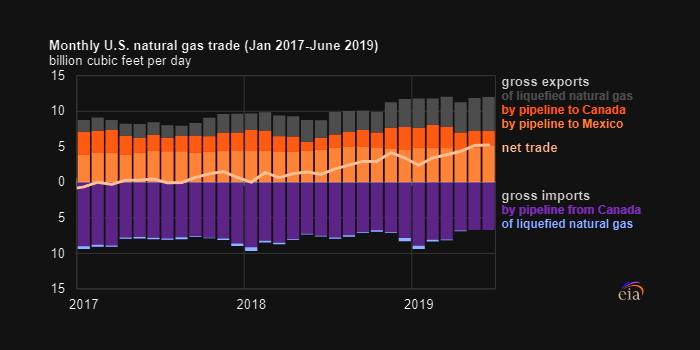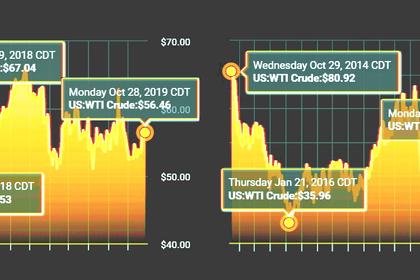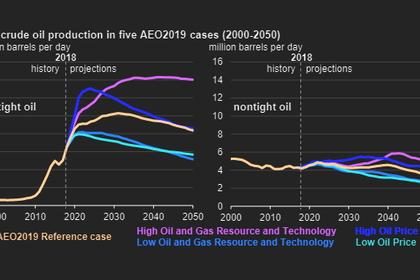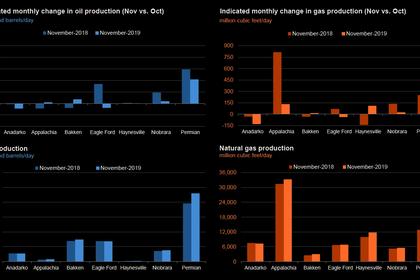
U.S. GAS EXPORTS UP TWICE

U.S. EIA - From January through June of 2019, U.S. net natural gas exports averaged 4.1 billion cubic feet per day (Bcf/d), more than double the average net exports in 2018 (2.0 Bcf/d), according to data in the U.S. Energy Information Administration's (EIA) Natural Gas Monthly. The United States became a net natural gas exporter (exported more than it imported) on an annual basis in 2017 for the first time in almost 60 years.
The United States exports natural gas by pipeline to neighboring Canada and Mexico and exports liquefied natural gas (LNG) to several other countries. Much of the recent increase in total exports is a result of more LNG facilities coming online. Total U.S. exports of LNG through the first half of 2019 were 37% higher compared with the same period in 2018. Total U.S. LNG export capacity as of June 2019 was 5.4 Bcf/d across four facilities and nine liquefaction trains.
Two new liquefaction units—referred to as trains—came online in the first half of 2019: Cameron LNG Train 1 in Louisiana and Corpus Christi LNG Train 2 in Texas. Cameron LNG was the fourth U.S. LNG export facility placed into service since February 2016. Cameron LNG, which will have a capacity of 1.7 Bcf/d when its three liquefaction trains are completed, shipped its first cargo in May 2019 (as part of the initial commissioning process) and then another one in June before ramping up operations in July and August. Corpus Christi LNG Train 2, with a capacity of 0.6 Bcf/d, shipped its first cargo in July and reached substantial completion in September.
More LNG facilities have come online in the second half of 2019: the first train at Freeport LNG in Texas, with a capacity of 0.7 Bcf/d, and the first ten trains at Elba Island in Georgia, with a capacity of 0.03 Bcf/d. These two new LNG export facilities, along with the completion of Cameron LNG, will increase U.S. LNG export capacity to 8.9 Bcf/d by the end of 2020 from 4.9 Bcf/d at the end of 2018.
Although U.S. LNG exports have grown substantially, most U.S. natural gas trade is transported via pipeline across shared borders with Canada and Mexico. In the first half of 2019, net exports of natural gas by pipeline to Mexico grew by 5%, and net exports of natural gas by pipeline to Canada remained relatively flat. In every month from April through August, U.S. natural gas exports by pipeline have exceeded natural gas imports by pipeline, the longest consecutive stretch of exporting more natural gas by pipeline than importing by pipeline on record.
U.S. pipeline export capacity to Canada grew in the last few months of 2018 when the second phase of both the Rover pipeline and the new NEXUS pipeline entered service, transporting natural gas from the Marcellus and Utica plays in the Appalachian Basin to the St. Clair point of exit northeast of Detroit, Michigan. Total U.S. natural gas exports to Canada reached 3.3 Bcf/d in February 2019, the highest level this year as of August 2019.
U.S. pipeline net exports of natural gas to Mexico in the first half of 2019 averaged 4.9 Bcf/d, 0.4 Bcf/d higher than the average for the first half of 2018. Pipeline deliveries to Mexico grew in 2019 as new projects such as the Texas-Tuxpan pipeline transported natural gas from the U.S. Permian Basin to demand centers in Mexico. U.S. natural gas exports by pipeline to Mexico reached all-time highs of 5.2 Bcf/d in June 2019 and 5.3 Bcf/d in July 2019.
According to EIA's Short-Term Energy Outlook, net natural gas exports are expected to continue rising through the end of 2019 as additional LNG export capacity comes online and natural gas pipeline infrastructure in Mexico is placed into service. EIA expects the United States to continue to export more than it imports with net natural gas exports averaging 4.6 Bcf/d in 2019 and 7.2 Bcf/d in 2020.
-----
Earlier:



















